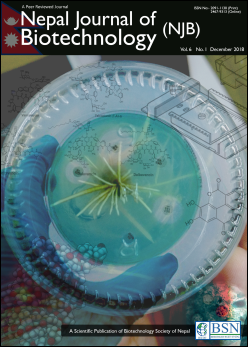Isolation of Polyhydroxybutyrate (PHB) Producing Bacteria, Optimization of Culture Conditions for PHB production, Extraction and Characterization of PHB
DOI:
https://doi.org/10.3126/njb.v6i1.22339Keywords:
Bioplastics, Biopolymer, Polyhydroxybutyrates, PHB, Fourier Transform Infra-Red Spectroscopy (FTIR)Abstract
Polyhydroxybutyrates (PHBs) are energy reserves synthesized by different micro-organisms such as Alcaligenes, Pseudomonas, Staphylococcus, Algae, in excess of carbon and limitation of nutrients like nitrogen. These biopolymers are suitable alternate to synthetic carbon-based polymers. However, the high production cost limits their commercialization. The aim of this study was thus, focused on optimization of culture condition for maximum PHB production in an attempt to reduce the production cost. The micro-organisms for this purpose were isolated from 4 different soil samples and screened for PHB production. Culture conditions for these organisms were optimized by changing the parameters, viz., incubation time, pH, carbon source and NaCl concentration. Thus, optimized culture condition was used to culture the isolates for extraction of PHB and its analysis. The extracted compounds on FTIR-analysis gave characteristic C=O peak of PHB, thus, confirming the seven isolates to be PHB producers. Results for optimized parameters for the isolated PHB positive species showed that synthesis of PHB was maximum at 48 hours i.e. during the early stages of stationary phase. However, different isolates favored different culture conditions. Highest PHB accumulation and growth of isolates were seen at pH 7 and 9. Similarly, it was observed that glucose was favored by 4 isolates and sucrose was favored by 3 isolates. Interestingly, NaCl concentration did not cause significant effect on neither the bacterial growth nor the PHB production. During the extraction of PHB from the optimized culture conditions, extraction of PHB from broth gave significant yield than that from agar. A good PHB yield from broth amounting to 36.41% and 34.59% was observed for Bacillus pasteurii and Micrococcus luteus respectively, showing a potential for their exploitation in industrial PHB production. At optimized conditions, 7 isolates exhibited significant PHB yields, thus showing a potential for further exploitation.
Downloads
Downloads
Published
How to Cite
Issue
Section
License
Copyright Notice:
The manuscript submitted to NJB must be an original contribution, not previously published and should not be under consideration for publication elsewhere. When the manuscript is accepted for publication, the authors agree to automatically transfer the copyright of the article to the publisher. It should grant permission to any third party, in advance and in perpetuity, the right to use, reproduce or disseminate your article, according to the NJB copyright and license agreement.
Authors transfer copyright to the publisher as part of a journal publishing agreement but have the rights to: Share their article for Personal Use, Internal Institutional Use and Scholarly Sharing purposes, with the NJB applies the Creative Commons Attribution-NonCommercial CC BY-NC license to all the works we publish after Jun 2020 (Before it was CC BY-NC-ND). Under this license, authors agree to make articles legally available for reuse, without permission or fees, for virtually any non-commercial purpose. Anyone may remix, adapt, and build upon your work non-commercially, and although their new works must also acknowledge you and be non-commercial, they don’t have to license their derivative works on the same terms. More details on CC BY-NC refer to its Licence Deed and Legal Code.






